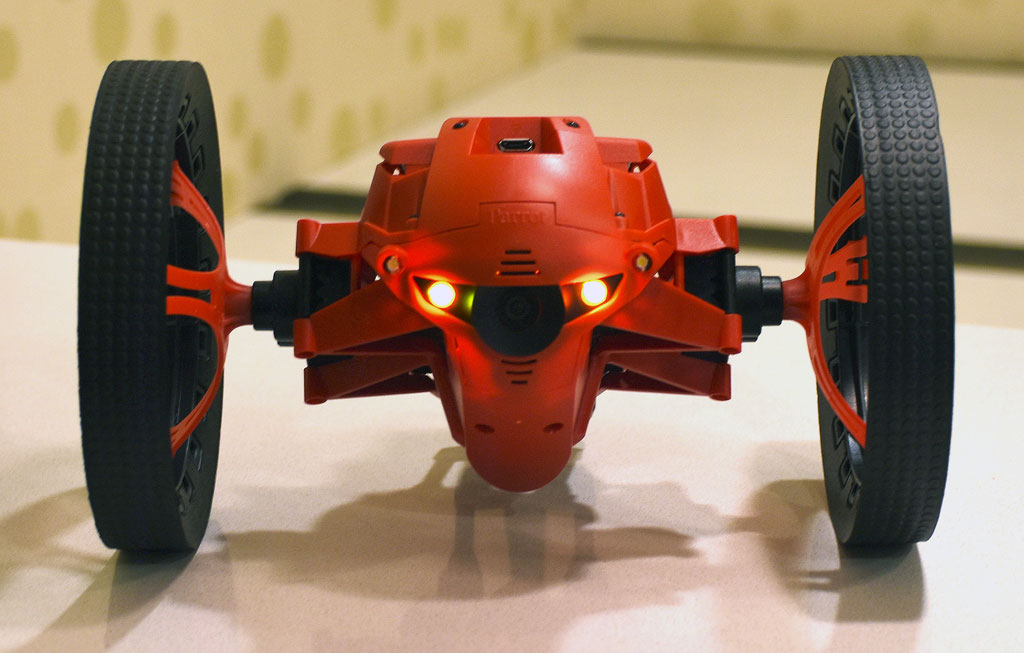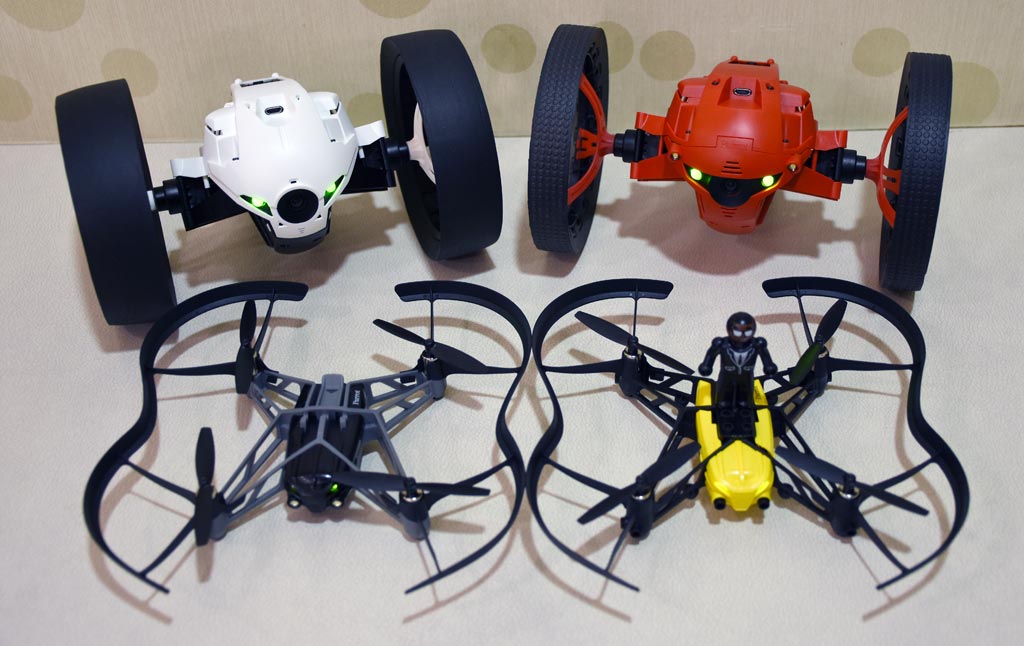
Drones can come in all sizes, as Parrot likes to demonstrate with its MiniDrones line of more diminutive gizmos. And now, it seems there’s a small army of them—on land, air and sea. Previous designs have been augmented in various ways to make this new batch of mini robots smarter, sleeker and more precise. I took a few for some testing and found them to be fun for as long as the battery could last.
It might not seem like it off the bat, given the relatively simple look and feel these little guys have, but there is a lot going on under the surface. The processing power and constant connectivity required to get one of these drones is a drain on any battery, and that’s been the hump manufacturers like Parrot have been trying to get over.
Design
Remember the Jumping Sumo and Rolling Spider? Well, those are the predecessors that kicked off this “new generation” of drones. For this review, I looked at two Jumping Race Drones and two Airborne Drones with slightly different looks and features.
It’s a bit confusing at first, but Parrot decided to go with two models, and three styles and names for each. I had the Jett (white) and Marshall (red), representing one of each model. The Jett had the fatter wheels, while the Marshall, being the Jumping Night, had slimmer wheels and a couple of other things.
These can both jump up to 2.4 feet, spin 360-degrees, make 90- or 180-degree turns and go pretty fast for their size (just under 13km/h). The two are basically the same in every way, save for the Jumping Night having an IR camera and built-in LED headlights to wade through the dark.
For the two flyboys, I had the Flying Night Drone and Flying Cargo Drone. Again, the similarities are considerable between them, except for their namesakes. The Night Drone has two LED searchlights at the front, and the Cargo Drone has a small Lego-friendly brick at the top of its hull to carry light pieces, including your favourite Lego characters. There is one that comes in the box
Both can do various flips, take aerial photos from a camera facing down at a 90-degree angle and fly predetermined paths set through the piloting app that controls them, FreeFlight 3. The app is free to download for iOS and Android.
Parrot smartly includes bumpers to protect both the rotors and objects they would inevitably chop into, especially since these are as much for indoor use as they are for outside.
There are also two hydrofoil drones, but I didn’t get review units of these, and so, couldn’t test them out.

Performance (Jumping Race Drones)
The video gives you a small glimpse of how well these do, but suffice it to say, they are better at doing more than their predecessors were. The rolling drones have a better centre of gravity, which keeps them stable along a straight line and when weaving with turns, spins and jumps. They do make different noises—a way to cast a little more identity to them—but the gist here is about how much running around they can do.
They can snap video clips and photos, albeit at a low-resolution that doesn’t make them all that satisfying. At 640 x 480 VGA, its going to be a disappointment for anyone looking to merge footage with something in HD from a smartphone or other camera. The divergence is huge, and that makes the feature a little less impactful, as a result.
The built-in microphone on both meant I could speak through either drone, so long as I had a pair of headphones with an inline mic plugged into the device that was running FreeFlight 3 to control them.
The thing is, the ancillary features these guys offer can affect the kind of battery life you get out of them. Rolling and jumping around with the Marshall’s headlights on made it last shorter than the Jett. The fatter wheels on the Jett may have given it better acceleration, but they are soft, and I would hesitate to go too hard on rougher surfaces outdoors. Inside, it’s great, and the grip is impressive, regardless of whether it’s tile, hardwood, laminate or carpet.
Whatever the case, the small 550mAh batteries these use might last 15 minutes of action. More, if you keep it idle intermittently. The good news is that Parrot tried to shorten the wait on the other end by putting a larger 2.4Amp inside that can have the battery charged back to full in only 25 minutes. I tried it and that number, give or take a minute or two, is indeed accurate.
Performance (Airborne Drones)
 Many of the same performance perks and caveats apply to the two flyers as well. The Night Drone has two LED lights that point ahead, not down, thereby making it impossible to illuminate a subject for the camera below. Again, it’s the same VGA camera on both of them, except that neither has any advantage over the other in image output. There is no video recording for these guys, by the way. Oh, and there is no preview of what the camera sees on the app, either.
Many of the same performance perks and caveats apply to the two flyers as well. The Night Drone has two LED lights that point ahead, not down, thereby making it impossible to illuminate a subject for the camera below. Again, it’s the same VGA camera on both of them, except that neither has any advantage over the other in image output. There is no video recording for these guys, by the way. Oh, and there is no preview of what the camera sees on the app, either.
The Cargo Drone was funny, in part, because of the mini action figure that came with it. Seeing it standing up as the drone flew around made me smile a few times. The great thing is that the brick on top can fit any Lego piece that can stay on there. I imagine this could open a slew of possibilities in bringing the drone into the Lego universe for both kids and adults, alike. Anyone looking to have a Lego adventure with their children might like this sort of crossover. Don’t take that as a green light to pack on weight though. I didn’t have Lego pieces, but tried taping slightly heavier plastic items to the hull, and it was clear that it needed to push harder to fly.
What I liked about both of these is their relative durability. These are very lightweight drones, and wind gusts outside will push them off course. At least crashing into objects isn’t a sure sign that they may be damaged beyond repair, thanks largely to the bumpers included inside. Rotors can be replaced for cheap, though you do need to be careful about the pieces that hold them in place. If those go awry, the whole body may need replacing.
There are plenty of tricks these little guys can do. Forward flips, back flips, rotations and more. It’s certainly a more fulfilling repertoire, and they look good doing them, too. Selecting the trick I wanted, I then double-tapped the screen to trigger it. With some practice, it’s possible to learn how to quickly switch between tricks and do them in different sequences while flying the drone around. I tried, contorting my finger in the process, but managed two tricks in pretty close succession.
Personally, I would like to see Parrot consider making a small joystick controller for these MiniDrones, like it did for its larger models. The precision and control, plus the physical feedback, would make them easier to commandeer, or at least easier to get better at flying them. The FreeFlight 3 app is good, and using it on a smartphone or tablet is fairly simple. It’s just that maneuvering is made a little more challenging when the screen doesn’t always register exactly how much pressure you’re putting on.
Final Thoughts
In my mind, testing these gave me a few ideas on how to scare the wits out of people. I’m no prankster, but in the spirit of Halloween, the small size, random noises and overall feature set make them easy to appreciate for the more menacing among us. Kids will also undoubtedly find them cool to play with, possibly causing parents to grimace anytime they fly it a little too close to something valuable in the home.
All joking aside, the MiniDrones are loads of fun, albeit in shorter bursts. The faster charging gets you up and running in much less time than before, but the frequency of the “battery low” symbol is one of those trade-offs that goes with the territory of playing with them. Swapping batteries is always an option, and extras are available, if you want to go that route.
The impending winter may give you pause on picking up one of these drones, but in fairness, much of the time I spent with them was indoors. Having some open space in your home does help to avoid accidents or negate collisions.
The MiniDrones are available at Best Buy now, and include the various different styles that Parrot has produced.









